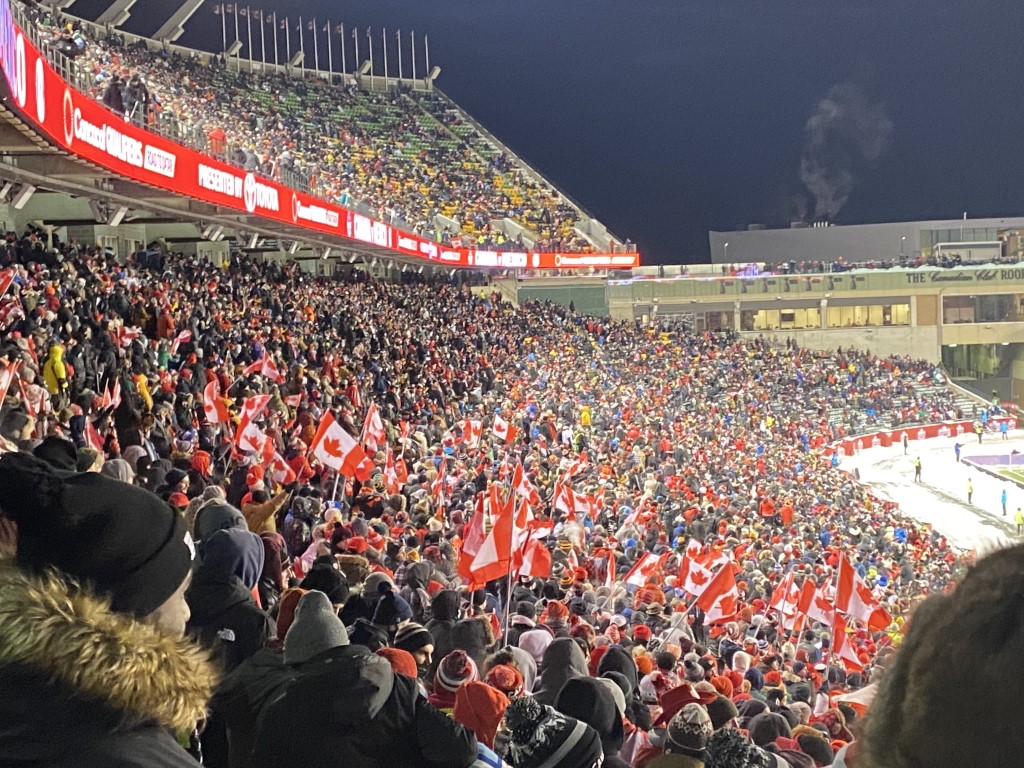Canada and the Quest for the World Cup

by Douglas MacDonald
My friend Michael is a huge soccer fan. Years ago, in his parent’s basement, he was disappointed when I didn’t want to play the FIFA video games. I always opted for Super Smash Bros instead. More than once, he insisted on watching an important soccer match and I would sit on the couch, drink a Coke, and count the minutes until the boredom would end and we could do anything else.
It was mid-October when Michael asked me if I would accompany him to the World Cup qualifying match at Commonwealth Stadium on November 16. He assured me that the game between Canada and Mexico would not only be an important historical event, but also a ferocious battle. I hadn’t seen my dear pal much lately, and the fall weather had been pleasant so far, so I thought, what the hell? Count me in, buddy!
Michael informed me that the FIFA (Fédération Internationale de Football Association) World Cup takes place every four years since its inaugural tournament in 1930 and is the single most viewed sporting event in the world. To qualify, Canada must place in one of the top three positions out of the 35 countries in CONCACAF (The Confederation of North, Central America, and Caribbean Association Football). Canada hasn’t qualified since 1986. However, the current lineup of players has been called the ‘golden generation’ and hopes are high that they can lead us to qualify in the FIFA World Cup, which kicks off in November 2022, hosted by Qatar.
Stakes were high as the LRT pulled into Stadium station and dropped me and my friend Michael off. We followed the flurry of crowds past mountains of snow that clung to signposts and clambered over chain-link fences. It was a November evening in Edmonton that promised a blizzard and plummeting temperatures of -16 degrees Celsius.
The lights from the stadium glared into the cold night sky. The line of fans were disorganized regiments of hopeful spectators bundled in snow pants, toques, mittens, and Canadian colours. A handful of Mexican flags worn as capes fluttered in the crowd – a child who wore a traditional Mexican wrestling mask clung to their caped caregiver while they slogged through the snow.
I imagine Mexico was sweating in their locker room, hoping their soccer cleats could cleave like crampons on the icy field. The pitch had been cleanly swept of snow; however, the corner kick areas were white with sleet and looked dangerously slick, while the snowbanks behind the boards must have reminded the adversaries that they were out of their element. Canada hadn’t defeated Mexico since 1976.
We heard the roar of the crowd as the game commenced and finally, clad in our puffy winter attire, we were inside the concrete colosseum and found our seats. The excitement around the soccer field was so palpable that everyone was standing up – also, it was too cold to sit on the snow-covered benches. There were nearly 45,000 people in the stands supporting this historic event, and I found myself next to my girlfriend’s ex-boyfriend. We laughed and joined the rumble of the crowd smiling. It’s a small world, after all.
With cold cans of Canadian lager in our mittened hands we cheered as Canada clearly dominated the field. Just before half-time, Canadian defender Alistair Johnston won the ball and took a shot at Mexico’s net. It was blocked and rebounded to Cyle Larin, who scored Canada’s first goal of the night: we went wild! Canisters of red smoke blew up around the stadium. Michael and I jumped and cheered in nationalistic pride, hi-fiving and yelling with the crowd as Canadian flags waved to their utmost height, like the many banners of a concrete ship that had finally found the wind.
Larin proved himself a talented force: he scored the second goal for Canada, and threw himself into a snowbank in celebration, laughing and hugging his teammates in a perfect Canadian moment. With 22 goals under his belt, he has tied Duane DeRosario for the record goals scored by a Canadian – DeRosario accomplished this feat in 81 games, Larin in 44.
Larin wasn’t the only force on Team Canada to be reckoned with. Many near goals occurred at the tip of Alphonso Davies’ toe. Always in the right place, the unassuming Davies stole a pass, darted miraculously across the field, and barely missed his shot. A giant cloud of tense, icy breath billowed above the stadium as 45, 000 people anxiously exhaled. We knew we were in the presence of a legend in the making.
Michael leaned over and told me that Alphonso Davies, a 21-year-old Canadian, is among the best soccer players in the world and widely considered the best left-back of his generation. Born in a refugee camp in Ghana, Davies moved to Canada at the age of 5 and eventually settled in Edmonton. Michael explained that Davies played organized soccer with Free Footie, an after-school league for inner-city elementary students who lacked the financial support to play elsewhere. After playing for the Edmonton International, and the Edmonton Strikers, the Vancouver Whitecaps picked him up at the age of 14, before the prominent and lucrative Bundesliga club in Munich provided a transfer payment of $13.5 million US (which included a performance-based bonus of up to a grand total of $22 million).
Mexico wanted the win and were not going to give up. At ninety-one minutes, Mexico’s Hector Herrera scored. Mexico was relentless. The pressure was on as they pressed the net and smashed shot after shot. Canada’s goalie, Maxime Crepeau, saved us from the purgatory of a tie several times, diving back and forth across the goal line, while the defenders tried to clear the ball from our end. It was a tight finish. Mexico fought until their last frosty breath caught in front of them on that snowy night in Edmonton. The crowd erupted like an icy volcano when the clock ran out with Canada victorious: 2 – 1.
Michael and I hugged and spilled flat, yellow beer over each other in a religious stupor of celebration. Mittened hands clapped while the masses, all emblazoned in red and white coats and furry toques, waved flags, sang Ole, and chanted in myriad accents and anthems. It was a cultural mosaic of proud Canadians cheering in the cold.
People had begun to scatter before the end of the game – perhaps that was wise – but we were thrilled to see it through. The line to the LRT was a nightmare, but it was worth it. People hustled and shoved shoulder to shoulder, but there was nowhere to go. In the throng of thousands, Michael and I turned to each other and decided to walk downtown to find a bite to eat instead of waiting for a crowded train.
Getting out of the crowd was harrowing; there were drunkards hollering and stubborn people with feet that seemed frozen onto the sidewalk. Choked by bus fumes and mouth breathers, we slithered through the swarm and found the walking path that followed alongside the LRT line, and made our journey towards Sherlocks Pub.
In the snowy ruts we ignored the cold with convivial conversation. We were reassured as we saw only one train pass by during the twenty-five-minute walk along the tracks. The LRT cars were cartoonishly crammed with red sweaters and flushed faces plastered against the glass windows like a thousand roses suffocating in a bottle.
We stamped our snowy boots and went inside the warm and calm reprieve of Sherlocks Pub. Upstairs, at a cozy table, Michael and I each ordered a pint of Guinness and a cheeseburger while Tragically Hip’s ‘Wheat Kings’ played in the background as we toasted Canada. Our pint glasses clinked together, and the double doors downstairs burst open with a swirling gust of snow closely followed by a rowdy pilgrimage of Yahoos yelling, Ole!

